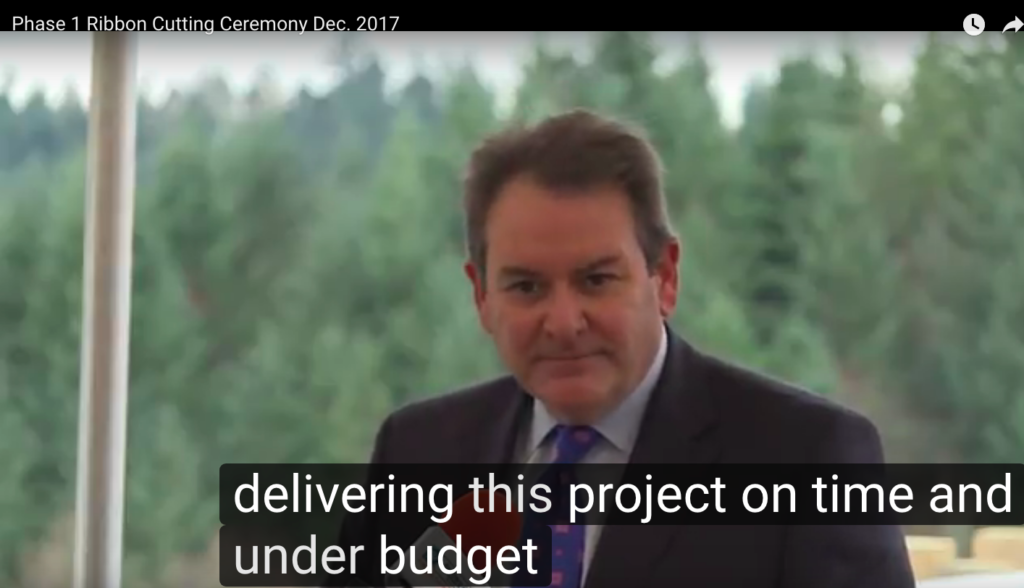The key to being on-time and under-budget: Orwellian double-speak
Oregon DOT projects are always on-time and under budget–because the agency simply disappears its original schedules and budgets.
Delayed, half-finished projects are officially described as “On-time and on-budget”
Oregon DOT routinely hides its waste, mismanagement and incompetence
The last bits of fresh asphalt have been rolled out, there’s fresh gleaming paint marking the shoulders and centerline, new directional signs have been posted and at the intersections, new traffic signals have been installed. This new highway is just about ready for eager drivers. Just one more task remains. A crack team of Oregon Department of Transportation (ODOT) engineers carefully re-locate the project’s goalposts so that it can claim that everything’s gone according to plan.
In 2017, ODOT held the ribbon cutting ceremony for a portion of the Newberg-Dundee bypass, a new four-mile stretch of highway just outside Portland. It’s the agency’s biggest current construction project. Officiating were the Governor, local dignitaries, legislators and the media. As part of the announcement, the agency’s director, Matt Garrett, boldly claimed that ODOT had delivered the project “on-time and under budget.”
Matt Garrett:
“our state lawmakers showed great confidence and trust in the Oregon Department of Transportation by approving the then 2009 Jobs and Transportation Act–it directed $192 million dollars toward this project. And today, we repay that confidence by delivering this project on-time and under-budget.
Here’s the video of the ribbon cutting ceremony:
The trouble is that’s not even remotely true.
What local leaders cut the ribbon for in December 2017 was less than half a project. ODOT had completed just four-miles of a proposed 11-mile long project. And it had paved only two lanes of the four lanes (although its built bridges that could carry four lanes in the future). An ODOT progress report in 2016 described the project as follows:
The Newberg Dundee Bypass is an 11-mile, four-lane access controlled expressway around the cities of Newberg and Dundee. JTA funding is constructing Phase 1 of the Bypass. Phase 1 will construct 4 miles of a two-lane expressway from OR 219 in Newberg to OR 99W in Dundee.
That’s actually just a tiny fraction of the proposed bypass. Let’s review the history here:
At the time of the Draft Environmental Impact Statement on the proposed Newberg-Dundee bypass (2003), total project costs were estimated at $222 million. Just two years later, after additional, more precise engineering analyses, the cost had ballooned 40 percent, to more than $311 million (Oregon Department of Transportation, 2005). By 2010, it was estimated that completing this project would require between $752 and $880 million (Federal Highway Administration and Oregon Department of Transportation, 2010). The project’s final environmental impact statement said that construction would start in 2015 and be finished in five years.
This kind of calculated prevarication about schedules and budgets is a well-established practice at the Oregon Department of Transportation. Former Director Matt Garrett repeatedly offered similar assurances about the failed plans to construct a $3 billion Columbia River Crossing. Even after the project was delayed for nearly two years (first, because it pursued an un-buildable design, and then had to be redesigned again, to provide adequate navigation clearance, he assured the public that it was “on schedule,” accomplishing this verbal sleight-of-hand by saying the project was on “the current schedule.” Again: continually moving the goalposts to wherever the ball happens to be is the way that this Department of Transportation stays on schedule. (And the revived project has a budget that has now ballooned to $7.5 billion and is likely to reach $9 billion).
The Department (and in this case its consultants, McKinsey and Company) were equally deceptive in 2017. At the behest of the Governor, the Oregon Transportation Commission hired McKinsey to conduct a management review of ODOT (based on delays and overruns for a variety of projects).
This pattern and practice of deceit and deception matters for a variety of reasons. First, unless one acknowledges one has a problem—that you’ve gone over budget and missed schedules—it’s impossible to imagine that you’ll undertake any corrective action. And ODOTs so-called management review represented more of a whitewash than any effort to improve practice. Second, it means that we ought to deeply discount any claims that the agency makes about how much it will cost and how long it might take to build any of its current proposed mega-projects.
Newberg-Dundee Bypass: Decades behind schedule, over-budget and only half-built
A bit more history about the Newberg-Dundee Bypass, which ODOT celebrated on being complete “on time and underbudget” in 2071. In fact, what we have today is a project that is in fact less than half-complete from what was originally announced. It’s both skinnier and shorter than originally announced. The first segment running from Newberg to Dundee has just two lanes paved in its four-lane right of way. The second segment, running from Newberg to Rex Hill, now referred to as Phase 2, is yet to be built or even financed.
In January of 2018, the Oregon Department of Transportation officially opened to traffic a portion of what’s called the Newberg-Dundee bypass, a road that serves as an alternative to US Highway 99W, a two-lane and four-lane highway that essentially forms the main streets of the two cities of Newberg and Dundee. As these two cities have grown, the combination of commercial traffic in the city’s downtowns and through traffic on highway 99W leads to frequent congestion. The project is also known as the “Pinot-Casino” highway, because it is the principal route from Portland to the region’s famous wine-growing region and to the state’s largest Native American casino.
Planning for the bypass has been underway for more than 15 years. The state struggled to come up with the money to pay for the project, and spend several years in an ultimately fruitless quest to persuade Australian road-builder Maquarie to undertake the project as a toll-financed public private partnership.

